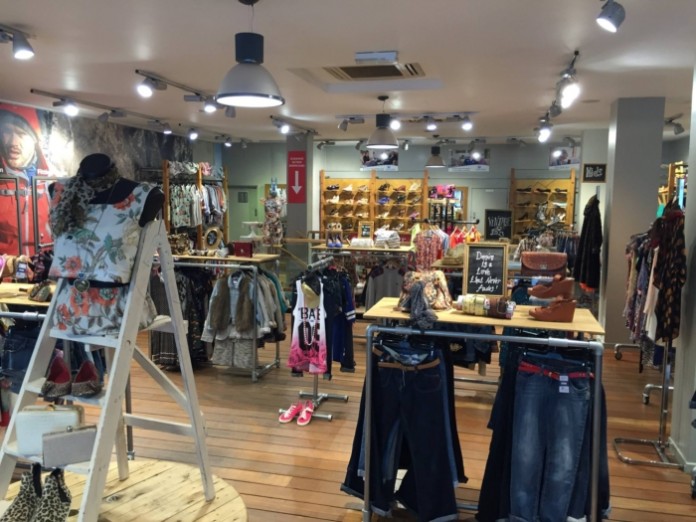Charity shops sometimes get a bad press from other retailers – not least because they can benefit from lower business rates. Too many charity shops can also, goes the argument, “lower the tone” of a precinct or High Street. So are charity shops the friends or foe of the traditional retail sector – and what role do they play in the local economy?
One charity that should know is St Peter’s Hospice. With 49 permanent outlets and several “pop up shops” operating at any one time, they are far and away the biggest charity shop retailer in Bristol. They employ some 175 full and part time staff as well as use the services of a staggering 1,000 volunteers.
These shops generate over £2 million net to fund the work of their hospice: each year the charity provides help free of charge to over 2,000 local people and their families dealing with a life-limiting illness.
“Without that source of revenue, we could not hope to carry out the incredibly important work we do,” says Business Manager Sian Rees. “Our shops deliver around 30% of our income. But we – like all the other excellent charities with shops locally – don’t just raise much-needed funds.
“We prevent thousands of tonnes of clothes and other goods going to landfill every year; we are big local employers; we provide training for volunteers coming back into the workforce as well as a social lifeline for many; and of course we enable a great many people to clothe themselves affordably.”
But how about the argument that charity shops have a negative impact on other retailers? There are now around 10,000 in the UK, and while numbers grew sharply during the recession there are signs that the sector has now slowed down. According to the Charity Shops Survey in 2015, income increased by just 2.6% last year – and most of that was fuelled by online sales.
Stuart Williams is a director of Williams Gunter Hardwick, the company that has acquired outlets for St Peter’s Hospice for the last 20 years, and he believes that the overall impact of charity retail is positive. “I think the point that is often missed by many of the retailers who complain about charity shops is that, without them taking space in secondary and sometimes tertiary locations, we would have gaps instead – which can rapidly turn a location into a ghost town.
“There’s no doubt in my mind that without charity shops, some arcades and shopping precincts in our suburbs would have struggled to survive the recession and changes in our shopping habits,” he maintains. “As well as enabling many hard-pressed landlords to weather the economic downturn, they stimulate footfall.
“We acquire outlets for a number of other charity retailers around the country, including Cats Protection, and the picture is the same in other locations too: growing online sales mean that we are spending less in total terms on the High Street… charity shops are actually playing a key role in getting people out to shop.”
For charities like St Peter’s Hospice, retailing is as serious a business as it is for any of the big brand operators, and they assiduously collect data on each of their stores to stay on top of what people are buying, how much to charge, which stores are faring better than others and just how much each contributes to the charity’s “bottom line”.
“We know to a penny what each outlet generates in sales and profits each week, ” says Sian Rees, “as well as what ‘brands’ do well in different shops around the city. Each shop takes in donations of clothes, furniture, books, shoes and bric-a-brac, and that contribution to the charity’s operation is also taken into account when profitability is calculated.
“Anything unsold after two weeks is recycled to another branch, so customers keep seeing fresh stock. And we also select goods to sell online or at auction where we think we’ll get a better price as we have a responsibility to the donor to achieve as high a price as possible for their donation.
“Sometimes you get a real gem handed in: an accordion donated at our Chipping Sodbury branch recently fetched £7,300 on eBay.”
At the other end of the scale, items of clothing not sold in the shops are sold to a recycling partner, much of which finds its way to the developing world. St Peter’s Hospice alone generates almost 1,000 tonnes of these items each year.
“The data we receive enables us to plan where to open our next store, or whether to move on to a nearby location if the rent rises at the end of a lease and the sums no longer add up, says Sian.”
Whilst Williams Gunter Hardwick work with St Peter’s Hospice to maintain a “hit list” of target locations, St Peter’s Hospice are always willing to consider new locations within the Greater Bristol area, so always welcome ideas of outlets from 1,000 sq. ft. up to 10,000 sq. ft. – the larger space units selling furniture. It is thought that there is room for at least a dozen more outlets for the charity. Moreover, the strength of covenant offered by St Peter’s Hospice is better than many national retail chains.
“And yes, we do have to compete with other operators when we negotiate leases, so we are paying market rents on permanent leases, and we also commit to a locality,” says Sian.
Into the future, St Peter’s Hospice foresees more and more goods being sold online as well as extending their house clearance service.
Says Stuart Williams: “We’ve acquired a warehouse in Avonmouth for the hospice to accommodate its rapidly expanding eBay operation as well as developing its house clearance business. The charity has also established several ‘clearance stores’ where you can really pick up a bargain, and we have also negotiated leases on ‘pop up’ stores.
“One example is the former Kathmandu at 11-13, Queens Road in Clifton which St Peter’s Hospice are occupying on a temporary basis whilst the landlord secures a change of planning use. Local traders have commented on how footfall has increased since its opening.
“You have to be as innovative and business-like as any High Street chain to succeed as a charity retailer,” concludes Stuart Williams, “and St Peter’s Hospice are recognised nationally as one of the very best at what they do.”






















